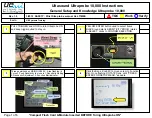
USB Multilink ACP - Technical Summary
Multilink ACP Pin-Outs, Ports A, B, C
The user can take advantage of debug modes to halt normal processor execution and use a computer to control the processor.
The user can then directly control the target's execution, read/write registers and memory values, debug code on the processor,
and program internal or external FLASH memory devices.
4
Usage
The USB Multilink ACP can communicate with ARM Cortex microprocessors by connecting a ribbon cable between the target's
debug header and one of the multiple ports on the Multilink. Do not attempt to use multiple ports at once, as this may damage
both the target processors as well as the Multilink.
The USB Multilink ACP interfaces will work with targets whose processor power supply is in the range of 1.8V to 5V.
Multilink ACP Header Layout (Pin 1 Highlighted)
There are two LEDs on the Multilink interface. The blue LED indicates that the interface is powered and running. The yellow
LED indicates that target power has been detected.
Note:
To avoid improper connections, the red stripe of the ribbon cable should always be oriented towards Pin 1, both on the
Multilink port and the target processor header.
The USB Multilink ACP is a USB device. If a USB Hub is used, it must be a self-powered hub (i.e. with its own power supply). By
default, the USB protocol used is USB 2.0.






















